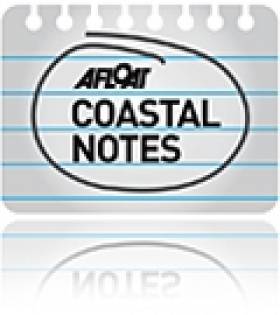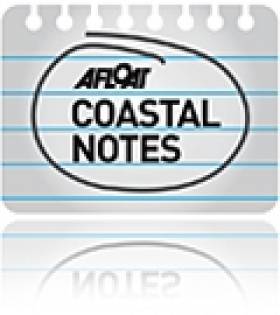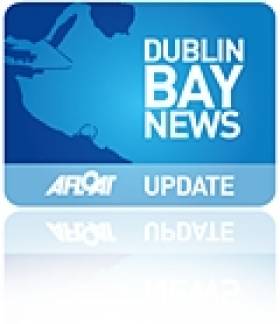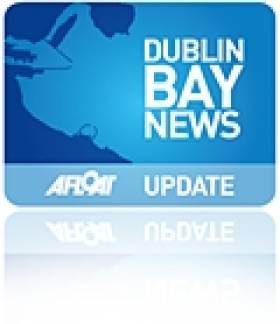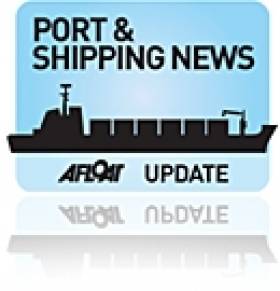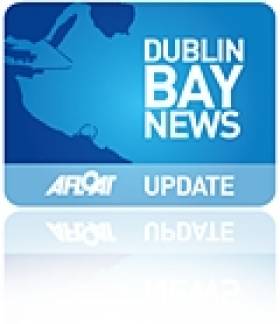Displaying items by tag: Shackleton Endurance Exhibition
Shackleton’s 'Present Day' Endurance Faces the Scrap-Yard
#ShackletonShips – With attention focused on job losses at BAE Systems shipyards in Scotland and Portsmouth which is to cease shipbuilding in 2014, the Royal Navy base is also home to the former Antarctic ice patrol survey vessel, HMS Endurance, writes Jehan Ashmore.
As previously reported, the fate of HMS Endurance, which was named in honour of the 'original' Endurance which sank after trapped in ice during Sir Ernest Shackleton's Imperial Trans-Antarctic expedition of 1914-1918, and according to Ships Monthly is now likely to be scrapped.
HMS Endurance, albeit not built at Portsmouth's historic shipyard that notably launched King Henry VIII's Mary Rose (see new museum) more than 500 years ago, also suffered a serious incident having nearly foundered off Chile in 1991. She was towed to the UK but was never repaired.
As previously reported on Afloat.ie, there are two other vessels directly named in honouring the famed Irish-born polar explorer.
Firstly is the 1995 built RRS Sir Ernest Shackleton which was originally MV Polar Queen built for Rieber Shipping of Bergen.
Ships Monthly also reports that the Norwegian company recently sold sister MV Polar Protector (A173) to the UK Ministry of Defence for £51m as the current Royal Navy patrol and survey vessel for the South Atlantic and Antarctic.
The second vessel is the Dublin Port Company tug Shackleton named in 2010.
#SHACKLETONcalling – In celebration of the greatest survival story of all time!.. All Shackletons, Creans, McCarthys and descendants of the 28-strong crew of the legendary Endurance expedition (1914-16) will congregate for a momentous Gathering at Dún Laoghaire's Shackleton Exhibition this Friday 11 October.
It was 99 years ago that saw three renowned Irish Explorers - Sir Ernest Shackleton, Tom Crean and Tim McCarthy - embark on what would become the most legendary Antarctica voyage ever – the Endurance expedition.
Five months later disaster struck when the ship was beset by ice leaving the 28 men stranded in 24-hour darkness in the middle of the freezing ocean surviving on seals and penguins for months on end. And then their ship was engulfed by the ocean...
Attendees at this October's Gathering event will relive this remarkable story of survival and persistence told through the actual photographs and video clips taken on the expedition.
Everyone with an interest in the Endurance story is welcome to attend and meet the Hon. Alexandra Shackleton (Sir Ernest Shackleton's granddaughter), four generations of Creans (including Tom Crean's Great-Great Grandson, 13 year old Ben O'Brien) and many more descendants of these remarkable men.
The exhibition, which opened at Dún Laoghaire Ferry Terminal last year, features over 150 real photographs and videos recorded by the expedition photographer, Frank Hurley including the video of the Endurance disintegrating and sinking.
Each picture brings a different part of the story to life: the treacherous open boat journey to Elephant Island, the endless trek across the ice, the impossible 800-mile rescue mission across the South Atlantic Ocean.
The expedition goes down in history as one of the most significant maritime rescue feats of all time. After more than twenty-four gruelling months, the skill, the bravery, the extraordinary persistence of these men and their heroic Irish leader, brought every crew member from the Endurance Expedition home safe and sound.
The Gathering event is to take place this Friday at the Shackleton Exhibition at the front of the Ferry Terminal in Dún Laoghaire and is timed for 11am to 12.30pm.
All Shackletons, Creans McCarthys and other descendants of the Endurance crew are welcome free of charge.
Admission to the exhibition for other attendees is €5 per person.
A special lunch with talks on the Endurance Expedition will take place at the Royal St. George Yacht Club from 1pm to 5pm, cost €20. A limited number of places are still available so please book early.
The Shackleton Exhibition is open all year round. Further information: www.shackletonexhibition.com
Shackleton’s Ships Past & Present and ‘Endurance’ Exhibition
#ShackletonShips – Sir Ernest Shackleton who led the Imperial Trans-Antarctic expedition of 1914-1918 is remembered and honoured in different forms, writes Jehan Ashmore.
Notably, three vessels of which two are named after the Irish-born explorer and the other is named after the ice-trapped exhibition ship, Endurance. The incident of course would result in the remarkable polar rescue mission as previously reported of the compelling exhibition currently on display in Dun Laoghaire.
The present day HMS Endurance (A171) is awaiting a decision on her future as she lies in her home port of Portsmouth, following a near-floundering off Chile in 2008. She had been employed as a hydrographic and support vessel for British Antarctic Survey (BAS), which is responsible for the UK's national scientific activities in Antarctica.
Her successor, RRS Ernest Shackleton, which is primarily a logistic ship is used to re-supply survey stations with occasional science and specialist tasking. Hear and see her ice-strengthened hull crunch through sea-ice with this VIDEO CLIP.
RRS James Clark Ross is her fleetmate and she has some of Britain's most advanced facilities for oceanographic research and is the platform for most marine science undertaken.
During September/October, of each year both vessels registered in Stanley, Falklands Islands, sail from the UK and return the following May/June.
The second 'Shackleton' as previously reported is a Dublin Port Company tug which was named in 2010.
For further information on the Shackleton Endurance Exhibition: 'Triumph Against All Odds' which features stunning photographs taken by expedition team-member Frank Hurley and much more in the Dun Laoghaire Ferry Terminal, visit www.shackletonexhibition.com
Lecture: Shackleton and the Heroic Age of Antarctic Exploration
#LectureShackleton – Neale Webb, who is related to the family of the Irish-born Antarctic explorer, will present his lecture 'Sir Ernest Shackleton - Heroic Age of Antarctic Exploration' next Thursday, 14 February.
The talk which is for the Kilmacud-Stillorgan History Society, will be held at 20.00hrs in the Function Room of the Glenalbyn Sports Club in Stillorgan. All visitors are welcome –admission fee: €3
As previously reported, the five-man crew re-enactment of Shackleton's Epic Antarctic rescue continued, having this week reached landfall on South Georgia Island after sailing 800 nautical miles and taking nearly 12 days to complete to reach this destination, a key highlight of their journey.
To follow the team's latest blog reports, and to track the Alexandra Shackleton, a replica of the lifeboat James Caird used in the mission nearly a century ago, visit: http://shackletonepic.com/live-tracking/
Re-Enactment of Shackleton’s Epic Antarctic Rescue
#EPICVoyage - A crew of five led by British-Australian adventurer, Tim Jarvis, are attempting to become the first to authentically re-enact Sir Ernest Shackleton's Epic 800nm rescue mission across the Southern Ocean from Elephant Island to South Georgia.
The team, are on their 11th day onboard the Alexandra Shackleton which is heading for South Georgia, some 23 nautical miles away. The purpose built 22ft vessel is an exact replica of the lifeboat, James Caird, which made the same journey across the perilous ocean to reach the rugged peaks of the island.
Alexandra Shackleton was named after the Kildare born, polar explorer's only grand-daughter, who as previously reported on Afloat.ie was at the launch of the Shackleton Endurance Exhibition in Dun Laoghaire last September. The exhibition has a wonderful collection of photographs taken by Frank Hurley which relives the abandoning of the exploration ship Endurance, which became crushed in the pack ice, and the subsequent lifeboat rescue mission which can be read HERE in greater detail.
At only 22.5 ft/6.9m, Alexandra Shackleton, is a purpose built exact replica of the lifeboat, James Caird, which made the same journey across the perilous ocean to reach the rugged peaks of South Georgia.
The re-enactment of Shackleton's 'double' journey across sea and land using traditional gear will be according to Jarvis (46), a veteran of multiple polar expeditions, the most challenging expedition of his life.
Shackleton Epic has been in development since 2008, when Shackleton approached Jarvis with the idea of an expedition to honour one of the greatest leadership and survival stories of all time. To keep abreast of news of the re-enactment team, there's a BLOG and to track the vessel's progress, click HERE
Festive Events Mark Sign of the Times at Dun Laoghaire Ferry Terminal
#TERMINAL CHANGES - Motorists check-in area at the Dun Laoghaire Harbour ferry terminal, is currently a free car-parking facility with donations going to Barnardos, however Stena Line's HSS fast-craft service to Holyhead is to resume next week, albeit only for the festive season, reports Jehan Ashmore.
The Dun Laoghaire Harbour Company in association with Barnardos, has set aside the terminal for free-car parking which is available to next Sunday 16th December. Cars can park Monday to Wednesday (11am - 7pm) and Thursday to Sunday (12noon -8pm). The initiative not only supports a worthy cause but is to encourage customers to shop in Dun Laoghaire in the run-up to Christmas.
As for the HSS Stena Explorer, she reopens the route next Thursday 20th December, though only operating on 12 'selected' days over Christmas and early into the New Year, for sailing dates click HERE.
Also located at the ferry terminal (plaza) will be the Ice Kingdom Slides which opens tomorrow in addition on Marine Road /The Metals is the launch of the Dun Laoghaire Christmas Festival's Chalet Market plus life-size crib featuring 'live' animals outside St. Michael's Church. Also watch out for Firework Displays (on various dates) for details visit: www.dunlaoghaire.ie/christmas-festival/
The reduction in ferry operations in recent years has seen changes with the main ferry terminal entrance as previously reported on Afloat.ie transformed last September into the Shackleton Endurance Exhibition: 'Triumph against all odds'. The exhibition with the support of the harbour's 'masterplan', tells a survival story like no other of the Irish-born explorer Sir Ernest Shackleton and the Imperial Trans-Antarctic expedition of 1914-1917.
On display are more than 150 striking black and white photographs taken by photographer Frank Hurley and an exact replica of the James Caird; the lifeboat that proved so critical to the rescue. The exhibition also sales a range of related merchandise and other nautical-like items in its gift-shop.
Season Marks Return of Shackleton Autumn School
#SHACKLETON – A month from now sees the Shackleton Autumn School (26-29 October), now in its 12th year, take place in the Athy Heritage Centre-Museum, in Co. Kildare.
The Shackleton Autumn School was established to commemorate the explorer in the county of his birth, as he was born at Kilkea House, near Athy in 1874. The school claims to be the only annual polar event of its kind in the world and is a forum for discussion and debate on polar exhibition and presentation of artistic work relevant to Shackleton.
The autumn school will feature lecturers, drama, film, excursions, exhibits, and the Polar Exhibition 'Scott' for further details visit: www.shackletonmuseum.com/news/
Ports & Shipping Review: Stena HSS Comes and Goes, Shackleton Exhibition, Cork Harbour Open Weekend,Cargoship Dispute and Ferry Strike
#PORTS & SHIPPING REVIEW - Over the last fortnight Jehan Ashmore has reported from the Shipping scene where the Stena Line HSS seasonal-only operated Dun Laoghaire-Holyhead service completed its final sailing for the summer, though sailings are to resume over Christmas/New Year period.
Despite the HSS Stena Explorer's last high-season sailing on 11 September, the fast-ferry made a return call to Dun Laoghaire five days later, for a special freight-only charter, to load stage trucks following the Lady Gaga concert held in the Aviva Stadium, Dublin.
Incidentally the ferry terminal in Dun Laoghaire now features a new exhibition space, where the Tanaiste Eamonn Gilmore, T.D. officially launched the Shackleton Endurance Exhibition – 'Triumph Against All Odds'.
The Cork Harbour Open Weekend provided a great opportunity for locals and visitors alike to see what the world's second largest natural harbour has to offer, in terms of activities held on and off the water, including trips to Spike Island.
At Cobh a detained French registered fishing vessel was escorted to the town by the Naval Service OPV L.E. Roisin, following alleged breaches of technical fishing regulations.
A Dutch owned cargoship, the Julia, which docked in Drogheda Port faced arrest, following claims by its crew that they were owed in total $102,700 in unpaid wages to them.
The summer may be over, but that's not stopping Irish Ferries offering Autumn short shopping breaks and wine mini-cruises on the route to Cherbourg.
While rivals Celtic Link Ferries, found themselves taking additional business at short notice, as passengers were transferred from the cancelled Brittany Ferries Roscoff-Cork sailing, following strike-action by French staff over a dispute on new working conditions.
Celtic Link Ferries will however be expecting a response from customers as they take part in Gathering 2013, as the ferry operator are offering free car travel on 15th March next year in advance of St. Patricks Day celebrations.
Leo Varadkar, Minister for Transport, has appointed James Frater to the board of the Dublin Port Company. The Scot has held senior positions at ports in the UK, Egypt, Hong Kong and Oman.
Shackleton Endurance Exhibition – ‘Triumph Against All Odds’
#SHACKLETON – A new exhibition telling the remarkable story of Sir Ernest Shackleton's Imperial Trans-Antarctic expedition of 1914-1917, was officially launched by the Tánaiste Eamon Gilmore earlier this week, writes Jehan Ashmore.
Among those attending the launch of Shackleton Endurance Exhibition in the Dun Laoghaire Harbour Ferry Terminal, were the Hon. Alexandra Shackleton, the only grand-daughter of the Kildare-born explorer, ambassadors from the UK, Australia and Canada, officials from the Dun Laoghaire-Rathdown County Council and the Dun Laoghaire Harbour Company, in which the exhibition is an initiative within the harbour's masterplan.
The exhibition relives the Irish-born explorer's story and his 28 men, where the rescue mission from the abandoning of the exploration ship Endurance, in the "terrible beauty" of the White Continent, is only today, rightly seen as perhaps the most remarkable in exploration history which is told through wall texts, diary excerpts and photographs taken by the expedition's photographer Frank Hurley.
The story explores the shift to living from the ship and onto the pack ice, their daily life in the various camps, the treacherous weather and near-total darkness of the Antarctic winter, their isolation on Elephant Island and their final, triumphant rescue and return.
A full size exact replica of the James Caird, the lifeboat that proved so critical to the rescue mission is on display. Tells of bravery and miraculous survival of its crew and of their faith in their expedition leader, Shackleton is a survival story like no other.
An insight into those who lived through the horrors of the expedition is examined, and of the three Irishmen, Shackleton, Tom Crean from Kerry and Tim McCarthy from neighbouring Cork.
The exhibition was originally curated in the American Museum of Natural History, New York in 2000 and has since toured extensively in America, Ireland, Spain and the UK. The current exhibition is held in association with the Royal Geographical Society (and IBG). For further information visit www.shackletonexhibition.com


























